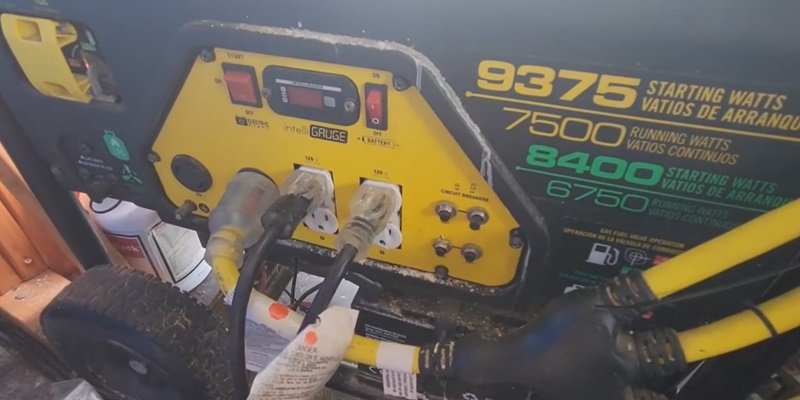Disclosure: This post contains affiliate links and I will be compensated if you make a purchase after clicking through my links. Learn More
To reset a generator circuit breaker, turn the breaker switch to the “off” position and then flip it back to the “on” position. When your generator experiences an electrical overload or short circuit, it can trip the circuit breaker to protect the generator and prevent any damage.
In such cases, you will need to reset the generator circuit breaker in order to restore power. Resetting the circuit breaker is a simple process that involves turning the breaker switch to the “off” position and then flipping it back to the “on” position.
This action will reset the breaker and allow the flow of electricity to resume. By following this procedure, you can successfully reset the circuit breaker on your generator and get your power back up and running.

Understanding The Basics Of Generator Circuit Breakers
Understanding the basics of generator circuit breakers is essential for proper maintenance and operation of your generator. Generator circuit breakers are an integral component of the electrical system of a generator. They play a crucial role in protecting the generator from overloading and short circuits, ensuring the safety of both the generator and connected electrical devices.
Generator Circuit Breaker Function and Importance
The function of a generator circuit breaker is to automatically interrupt the flow of electrical current in the event of an overload or short circuit. It acts as a safety mechanism to prevent damage to the generator and electrical equipment, as well as to safeguard against potential hazards such as fires or explosions.
Components of a Generator Circuit Breaker
A generator circuit breaker comprises several essential components, each contributing to its overall functionality. These components include:
- Operating Mechanism: This component is responsible for controlling the opening and closing of the circuit breaker contacts.
- Current Transformers: These transformers monitor the current flowing through the circuit breaker and provide feedback for proper operation.
- Protection Relay: The protection relay senses abnormal conditions such as overloads or short circuits and initiates the opening of the circuit breaker.
- Contacts: These are the conductive parts that open and close to interrupt or allow the flow of electrical current.
- Arc-Quenching System: The arc-quenching system is designed to extinguish the electric arc that forms during the interruption of current, preventing damage and ensuring safe operation.
How a Generator Circuit Breaker Works
A generator circuit breaker operates in a coordinated manner with the generator and the electrical system it is connected to. When an abnormal current is detected, the protection relay sends a signal to the operating mechanism of the circuit breaker to open the contacts. This interruption of current halts the flow of electricity, preventing damage to the generator and connected equipment.
The arc-quenching system comes into action during the opening of the contacts. It rapidly cools and extinguishes the electric arc, ensuring safe interruption of the current flow. This arc quenching process is crucial to preventing the formation of high-energy arcs that can damage the circuit breaker and surrounding equipment.
In conclusion, understanding the basics of generator circuit breakers is vital for maintaining the optimal performance and safety of your generator. Digesting the function and importance of generator circuit breakers, as well as familiarizing oneself with their components and operation, is essential for both generator owners and professionals in the electrical industry.
Identifying Generator Circuit Breaker Issues
Generator circuit breakers are crucial components of a generator system, designed to protect both the generator and the connected circuits from faults and overloads. However, like any other mechanical component, generator circuit breakers can experience issues over time. Therefore, it is important to be able to identify these issues to ensure the efficient and safe operation of your generator system.
Signs of a malfunctioning generator circuit breaker
Being able to recognize the signs of a malfunctioning generator circuit breaker can help you take corrective action promptly and avoid potential damage to your generator or connected circuits. Here are some common signs to look out for:
- Frequent tripping: If your generator circuit breaker is tripping frequently, it may indicate an underlying issue. Excessive tripping can disrupt power supply and signifies a potential overload or short circuit in the system.
- Burning smell: If you notice a burning smell near the generator circuit breaker, it could be a sign of overheating. Overheating can be caused by loose connections, overloaded circuits, or a faulty circuit breaker.
- Damaged or corroded components: Inspect the generator circuit breaker for any visibly damaged or corroded components. Physical damage or corrosion can affect the proper functioning of the circuit breaker and should be addressed promptly.
- Inconsistent power supply: If your generator is not providing a consistent power supply to your connected circuits, it could indicate a faulty circuit breaker. Inconsistent power supply can lead to unreliable operation and potential damage to electrical equipment.
Common reasons for generator circuit breaker tripping
Understanding the common reasons for generator circuit breaker tripping can help you troubleshoot the issue effectively. Here are some possible causes:
- Overload: Overloading the generator by connecting too many devices or appliances can cause the circuit breaker to trip.
- Short circuit: A short circuit occurs when a hot wire comes into contact with a neutral wire or ground, resulting in excessive current flow and tripping of the circuit breaker.
- Faulty circuit breaker: If the circuit breaker itself is faulty, it may trip even when there is no overload or short circuit. Faulty circuit breakers should be replaced as soon as possible.
- Ground fault: A ground fault occurs when a hot wire comes into contact with a grounded surface, causing an abnormal current flow. This can also lead to generator circuit breaker tripping.
Diagnostic steps to troubleshoot generator circuit breaker issues
When you encounter issues with your generator circuit breaker, a systematic diagnostic approach can help identify the problem and take appropriate action. Here are the steps to troubleshoot generator circuit breaker issues:
- Inspect the circuit breaker for any physical damage or loose connections. Tighten any loose components and replace any visibly damaged parts.
- Check the wiring connections to ensure they are secure and properly connected.
- Measure the current draw of the circuits connected to the generator to determine if there is an overload.
- If the problem persists, it may be necessary to consult a professional electrician to further diagnose and resolve the issue.
By following these diagnostic steps, you can effectively troubleshoot and address generator circuit breaker issues, ensuring the proper functioning of your generator system and enhanced safety.
Resetting The Generator Circuit Breaker: Quick & Easy Steps
When it comes to generator maintenance, knowing how to reset the circuit breaker is an essential skill for any generator owner. A tripped circuit breaker can cause sudden power outage, disrupting your daily activities. Thankfully, resetting the generator circuit breaker is a quick and easy process that you can do on your own, without the need for professional help.
Step 1: Ensure the generator is turned off and disconnected
Before performing any maintenance on your generator, it is crucial to ensure your safety by turning off the generator and disconnecting it from all power sources. This will prevent potential electric shocks or accidents during the circuit breaker resetting process.
Step 2: Locate the generator circuit breaker panel
Next, you’ll need to locate the generator circuit breaker panel. This panel is usually located near the generator or inside the generator housing. It’s important to note that the exact placement of the panel may vary depending on the model and make of your generator.
Step 3: Identify the tripped breaker and examine the cause
Once you’ve located the circuit breaker panel, visually inspect the breakers to identify which one has tripped. A tripped breaker will typically be in the “OFF” position or halfway between “ON” and “OFF.” Take a moment to examine the cause of the trip, such as overloading or a short circuit.
Step 4: Reset the generator circuit breaker to the “ON” position
With the cause of the tripped breaker identified and resolved, you can now reset the circuit breaker. To do this, firmly push the tripped breaker to the “OFF” position and then switch it back to the “ON” position. Ensure that the breaker is securely in the “ON” position before proceeding to the next step.
Step 5: Test the generator to verify proper functioning
After resetting the circuit breaker, it’s essential to test the generator to ensure it is functioning correctly. Reconnect the generator to the power source and turn it on. Verify that the generator is providing the expected power output and running smoothly. If you notice any abnormal behavior or further issues, it may be best to consult a professional.
By following these quick and easy steps, you can efficiently reset the generator circuit breaker and restore power to your generator. Remember to prioritize your safety by turning off the generator and disconnecting it from power before proceeding with any maintenance tasks.
Preventive Maintenance For Generator Circuit Breakers
Regular maintenance is crucial for keeping generator circuit breakers in top condition and ensuring their optimum performance. By implementing preventive maintenance practices, you can minimize the risk of unexpected breakdowns and costly repairs. This section we will discuss the importance of regular maintenance for generator circuit breakers and the common maintenance tasks that should be performed. Additionally, it will provide insights into the frequency and timing of these maintenance activities.
Importance of Regular Maintenance for Generator Circuit Breakers
Regular maintenance for generator circuit breakers is of utmost importance to ensure the smooth and uninterrupted operation of your generator system. Conducting periodic inspections and servicing can help identify potential issues early on, allowing you to address them before they escalate and cause significant damage or downtime. Here are some key reasons why regular maintenance is essential:
Enhancing Reliability: Regular maintenance helps to identify and rectify any underlying issues that may compromise the functionality and reliability of the circuit breaker. This proactive approach minimizes the chances of unexpected failures or breakdowns when the generator is needed the most.
Prolonging Lifespan: By following a consistent maintenance schedule, you can extend the lifespan of your generator circuit breaker. Addressing minor problems promptly prevents them from worsening, thereby reducing the risk of premature failure and the need for costly replacements.
Optimizing Performance: Well-maintained circuit breakers operate at their peak efficiency, ensuring the continuous and uninterrupted supply of power. Regular maintenance keeps the breaker in optimal condition, allowing it to perform its intended function effectively.
Common Maintenance Tasks for Generator Circuit Breakers
To maximize the performance and longevity of your generator circuit breaker, certain maintenance tasks should be performed on a regular basis. Here are some common maintenance tasks that you should include in your maintenance routine:
Visual Inspection: Regularly inspect the circuit breaker for any signs of wear, damage, or loose connections. Look for carbon deposits, overheating, and any indications of arcing or sparking.
Lubrication: Ensure that all moving parts are adequately lubricated according to the manufacturer’s recommendations. This includes hinges, latches, and pivot points that may require periodic oiling or greasing.
Testing and Calibration: Conduct regular testing of the circuit breaker’s trip mechanism and adjust the calibration if necessary. This ensures that the breaker operates within the specified parameters and provides accurate protection against overloads and faults.
Cleaning: Keep the circuit breaker and its surroundings clean and free from dust, debris, and moisture. Regularly inspect and clean air vents, contacts, and insulating materials to prevent any performance issues caused by poor cleanliness.
Frequency and Timing of Maintenance Activities
The frequency and timing of maintenance activities may vary depending on factors such as the manufacturer’s recommendations, environmental conditions, and the specific usage of the generator circuit breaker. However, it is generally recommended to perform the following maintenance tasks:
| Maintenance Activity | Frequency |
|---|---|
| Visual Inspection | Monthly |
| Lubrication | Semi-annually |
| Testing and Calibration | Annually |
| Cleaning | As needed or quarterly |
Adhering to this maintenance schedule will help to keep your generator circuit breaker in optimal condition and minimize the risk of unexpected failures. It is important to consult the manufacturer’s documentation and guidelines for specific recommendations tailored to your equipment.
Seeking Professional Help For Generator Circuit Breaker Troubleshooting
While it’s possible to troubleshoot and reset a generator circuit breaker on your own, there are certain instances where seeking professional assistance is necessary. Attempting to repair complex electrical equipment without proper knowledge and expertise can be dangerous and may result in further damage.
Therefore, knowing when to call in a professional technician is crucial for the safety and functionality of your generator. In this section, we will discuss the instances where professional assistance may be necessary, how to choose the right professional for generator circuit breaker repairs, and provide tips for working effectively with a professional technician.
Instances where professional assistance may be necessary
In some cases, it’s best to trust the expertise of a professional when dealing with generator circuit breaker issues. This includes but is not limited to the following scenarios:
- If you lack the necessary technical knowledge and experience to troubleshoot and repair electrical equipment.
- If you have attempted to reset the circuit breaker multiple times without success.
- If the circuit breaker continues to trip repeatedly, indicating a deeper underlying problem.
- If you notice abnormal sounds, smells, or visual signs of damage, such as burnt wires or melted insulation.
- If the generator is under warranty and any repairs should be handled by authorized professionals to avoid voiding the warranty.
Choosing the right professional for generator circuit breaker repairs
When seeking professional help, it’s important to choose the right technician to ensure the job is done correctly. Consider the following factors:
- Look for a qualified electrician or a technician who specializes in generator repairs.
- Check for certifications and licenses to ensure they have the necessary qualifications to work on electrical systems.
- Read reviews and testimonials from previous customers to gauge the technician’s reputation and level of customer satisfaction.
- Inquire about their experience with your specific generator model and the type of circuit breaker you’re having trouble with.
- Compare quotes from multiple professionals to ensure you’re getting a fair price.
Tips for working effectively with a professional technician
Once you have chosen a professional technician to assist you with your generator circuit breaker troubleshooting, it’s essential to establish a good working relationship. Here are some tips to help you work effectively with the technician:
- Clearly communicate the issue you’re experiencing, including any details about recent events or changes that may have triggered the problem.
- Ask questions and take note of the technician’s explanations and suggestions for future reference.
- Provide the technician with any documentation or manuals related to your generator and circuit breaker.
- Follow the technician’s safety instructions and avoid interfering with their work.
- Keep an open line of communication throughout the process to address any concerns or questions that may arise.
By seeking professional help when necessary, choosing the right technician, and working effectively with them, you can ensure that your generator circuit breaker issues are resolved efficiently and safely.
Read Here: How to Bypass GFCI on Generator
Frequently Asked Questions Of How To Reset Generator Circuit Breaker
How Do You Reset A Tripped Generator?
To reset a tripped generator, follow these simple steps:
- Turn off the generator.
- Locate the circuit breaker or reset button.
- Push the button or flip the circuit breaker to the “off” position.
- Wait for a few seconds.
- Turn the generator back on and check if it is running smoothly.
Where Is Circuit Breaker On Generator?
The circuit breaker on a generator is typically located near the control panel or power outlet. It serves as a safety device to protect the generator and electrical devices from damage due to overload or short circuit.
How Do I Reset My Power Supply Breaker?
To reset your power supply breaker, locate your electrical panel and find the breaker labeled for the specific circuit. Flip the breaker fully off, then back on again. This should reset the breaker and restore power. Make sure to troubleshoot the cause of the trip to prevent future issues.
Is There A Breaker On A Generator?
Yes, a generator typically has a breaker.
Final Thoughts
Resetting a generator circuit breaker is a simple process that ensures the smooth operation of your generator. By following the steps outlined in this blog post, you’ll be able to reset the circuit breaker quickly and safely. Remember to always prioritize your safety and consult a professional if you encounter any difficulties.
With this knowledge in hand, you’ll be well-equipped to handle any circuit breaker issues that may arise in the future. Happy resetting!


